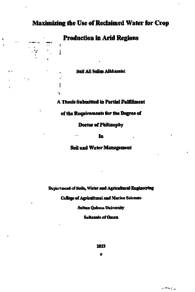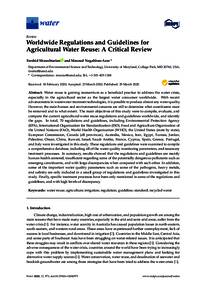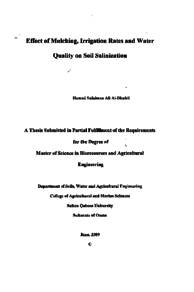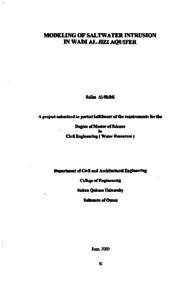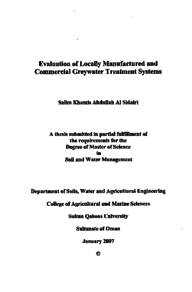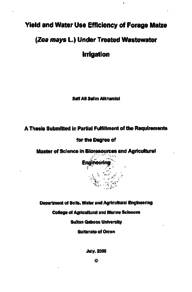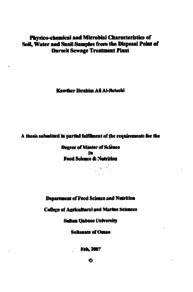Document
Maximizing the use of reclaimed water for crop production in arid regions
Publisher
Sultan Qaboos University
Gregorian
2013
Language
English
English abstract
Water resources augmentation together with conservation have been adopted by the Sultanate of Oman to combat water scarcity. Use of Reclaimed Water (RW) from sewage treatment for irrigation contributes to this strategy. Over 55 sewage treatment plants in Oman's different governorates produce more than 100 million m (Mm) of RW per year, which can be used for irrigation. Agriculture in Oman, contributes to partial food sovereignty and forms an important part of rural livelihoods. It accounts for 3.2% of the GDP in Oman in which fruits occupy an area of 53% followed by perennial forages (30%), vegetables (11%) and field crops (6%). If Oman decides not to use expensive water from desalination plants or fresh groundwater for irrigation, then the maximum area that can be irrigated solely with RW. will be determined by the day when demand for evaporatranspiration is maximum, During other days, there will be surplus of RW, unless a conjunctive water manag strategy, by supplementing RW with groundwater is formulated. If a conjunctive water management strategy is adopted, then the area under crops may be increased, and ter withdrawal will be reduced. Hence, the objective of this study was mainly to maximize the use of RW, supplemented by groundwater, by identifying short season crops, and changing the area under cultivation of such crops. Field studies were conducted to assess yield components of wheat, cowpea and maize crops rotation grown with RW for irrigation. Furthermore, the impact of RW irrigation on soil physical and chemical properties prior/after wheat, cowpea and maize cultivation were also assessed. Results showed that by using RW conjunctively with groundwater (assuming irrigation salinity of 1 ds m-' and RW availability of 38,267 m2 day!) cropping area can be increased from 695 ha to 2245 ha of wheat, 313 ha to 782 ha (250% increase) of cowpea and 346 ha to 754 ha (218% increase) of maize. Of the total irrigation requirement 24.24 Mm', 57.6% was to be met with RW and 42.4% was to be met with groundwater. The results on the effect of reclaimed water irrigation on soil physico-chemical characteristics indicated that the soil salinity in all soil depths decreased with time. It was 1.79 dS m' after wheat crop, 1.01 d m after cowpea, and 0.76 dS m-after maize. The soil pH was not affected by the irrigation with reclaimed water. The organic carbon did not show significant difference between the wheat and cowpea harvest timing. OC% was increasing with time in soil irrigated with reclaimed water. The saturated hydraulic conductivity, Ksat didn't show significant difference among the water types and the interaction between water types and soil depths. The soil nitrogen, phosphorus and potassium were not affected by any of the three water irrigation types. Total N was highest after cowpea harvest in RW irrigation, The highest concentration of P and K was found to be in the upper layers. P and K decrease with the increase in soil depth. Although RW didn't significantly show any effect with respect to sodium and magnesium concentration, it increased with time of harvesting. Calcium concentration was affected by the interaction of irrigation water type with soil depth. The highest Ca was observed in soil irrigated with desalinized water at 60 and 90 cm soil depth, though the RW contained higher Ca. RW didn't affect the soil trace elements concentration like Iron (Fe), Sulphur (S) and Manganese (Mn), Silicon (Si), Barium (Ba), Boron (B), Cobalt (Co), Lead (Pb) and Zinc (Zn). Fe concentration increased with soil depth and decreased with harvesting time. Mn decreased with time of harvesting. Si and B concentrations in the soil were found to be higher in the middle stage (after cowpea harvesting) for all soil depths. Ba decreased with time. Zn was increasing with time and decreasing with soil depth. The effect of RW was obvious on wheat agronomic characters. The RW irrigation increased wheat plant height (cm), chlorophyll, leaf area (cm), leaf length (cm), grain yield (t ha'') and the WUE (kg grain m). The RW irrigation improved all cowpea growth characters under study except the dry forage yield. The RW irrigation affected the growth parameters of maize. Nitrogen concentration was also higher under RW irrigation in respect to wheat tissue, cowpea pods and maize cobs. RW had no effect on the element concentrations in wheat straw, cowpea plants and maize plants except for Ni concentration in wheat plants, and Na and Mn concentrations ini maize plants. Based on the findings of this study, in order to fully utilize RW, it can be concluded that decision makers should consider use of the RW conjunctively with GW in areas where groundwater of relatively good quality is available for irrigating wheat, cowpea and maize (on a rotational basis). All trace elements were in a very low concentration in the soil after growing wheat, cowpea and maize crops and as such are not likely to pose any environmental concerns. There were no adverse impact of reclaimed water irrigation on yield and chemical characteristics of plants and grains of crops under study. The positive impacts of yield and WUE are significant.
Member of
Resource URL
Arabic abstract
إن استخدام المياه المعالجة المنتجة من محطات معالجة مياه الصرف الصحي لأغراض الري سيؤدي إلى تعظيم الموارد المائية مع الحفاظ عليها ومكافحة ندرة المياه في سلطنة عمان. يوجد في محافظات السلطنة المختلفة أكثر من 55 محطة معالجة مياه الصرف الصحي تنتج أكثر من 100 مليون متر مكعب من المياه المعالجة سنويا قابلة لاستخدامها لأغراض الري والزراعة التي تمثل ۳ ،۲ ٪ من الناتج المحلي الإجمالي في السلطنة تشغل الفواكه مساحة زراعية قدرها ۵۳% تليها الأعلاف المعمرة (۳۰٪) ثم الخضار بنسبة 11% والمحاصيل الحقلية بنسبة 6%. إذا قررت السلطنة عدم استخدام المياه المكلفة مثل المياه المنتجة من محطات التحلية أو المياه الجوفية العنية لأغراض الري فإن المساحة المروية الأدنى (Areamin) التي تنتج من كمية المياه المعالجة سيتم تحديدها عن طريق الحد الأقصى للبخرتتح اليومي (ETomax). خلال الأيام الأخرى سيكون هناك فائض (Surplus) من المياه المعالجة. وفي المقابل فإن المساحة المروية القصوى (Areamax) يمكن تحديدها عن طريق الحد الأدنى للبخرنتح اليومي (ETomin). خلال الأيام الأخرى سيكون هناك نقص (Deficit) يمكن تعويضه من المياه الجوفية. وبالتالي كان الهدف الرئيسي من هذه الدراسة لتحقيق الاستفادة القصوى من المياه المعالجة تكملها المياه الجوفية من خلال تحديد محاصيل قصيرة الموسم وتغيير المساحة المزروعة من هذه المحاصيل. أجريت دراسات ميدانية لتقييم مكونات المحصول من القمح واللوبيا والذرة الشامية بالتناوب بعد ريها بالمياه المعالجة. وقد تم تقييم تأثير الري بالمياه المعالجة على خواص التربة الفيزيائية والكيميائية بعد حصاد القمح و اللوبيا والذرة الشامية TI اد أظهرت النتائج أنه باستخدام المياه المعالجة مع المياه الجوفية (على افتراض ملوحة الري أقل من 1 ديسيمين م وكمية المياه المعالجة ۳۸۲۹۷ م" اليوم") يمكن زيادة المساحة من ۶۹۰ هکتار إلى 45 ۲۲ هکتار للقمح و ۳۱۳ هکتار إلى ۷۸۲ هکتار (۲۵۰ ٪ زيادة) للوبيا و346 هكتار إلى ۷۵4 هکتار (زيادة ۲۱۸ %) للذرة الشامية. من متطلبات الري الإجمالي (٢4، ۲٤ مليون م) يمكن استيفاء ۵۷ ،6 ٪ من المياه المعالجة و 4، 46٪ من المياه الجوفية.
أشارت نتائج تأثير الري بالمياه المعالجة على الخصائص الفيزيائية والكيميائية أن ملوحة الثرية في جميع الأعماق انخفضت مع مرور الوقت. كانت الملوحة (.EC) ۱ ، ۷۹ ديسيمين ما بعد حصاد القمح و ۱ ، ۰۱ بيسيمين مت' بعد اللوبياو76،. ديسيمين ما بعد حصاد الذرة. لم تتأثر حموضة التربة (pH) بالري بالماء المعالجة. لم يظهر الكربون العضوي (%OC فارقا كبيرا بين توقيت الحصاد للقمح واللوبيا. أظهرت نسبة الكربون العضوي (%OC) زيادة مع الوقت في التربة المروية بمياه المعالجة. لم يظهر التوصيل الهيدروليكي المشبع Ksar فارقا كبيرا بين أنواع المياه والتفاعل بين أنواع المياه واعماق التربة. لم تتأثر التربة من قبل أي من انواع مياه الري الثلاثة بالنسبة للنيتروجين والفسفور والبوتاسيوم. وبلغ النيتروجين الكلي بأعلى نسبة بعد حصاد اللوبيا في التربة المروية بالمياه المعالجة انخفض الفوسفور والبوتاسيوم مع الزيادة في عمق التربة وتم العثور على أعلى تركيز ليكون في الطبقات العليا اللترية. وعلى الرغم أن المياه المعالجة لم تظهر أي تأثير كبير فيما يتعلق بتركيز الصوديوم والمغنيسيوم إلا أن التراكيز ارتفعت مع الوقت بعد الحصاد. تأثر تركيز الكالسيوم أثناء التفاعل بين نوع المياه وعمق التربة وقد لوحظ أعلى نسبة الكالسيوم في التربة المروية بالمياه المحلاة في أعماق التربة ۹۰ و ۹۰ سم ، على الرغم من زيادة الكالسيوم أثناء الري بالمياه المعالجة. لم تؤثر المياه المعالجة على تركيز عناصر التربة النادرة مثل الحديد (Fe)والكبريت (S) والمنغنيز (Mn) والسيلكون (Si) والباريوم (Ba) والبورون (B) والكوبالت (Co) والرصاص (Pb) والزنك (Zn). كان هناك زيادة في تركيز الحديد مع عمق التربة وانخفاضا مع وقت الحصاد. انخفض المنغنيز مع وقت الحصاد. كما وجدت تركيزات السيلكون والبورون في التربة لتكون أعلى في المرحلة المتوسطة (بعد حصاد اللوبيا) لجميع أعماق التربة. انخفض الباريوم مع مرور الوقت وزادت نسبة الزنك مع وقت الحصاد والانخفاض في مستويات عمق التربة. كان تأثير المياه المعالجة واضحا بصورة ايجابية على مكونات الإنتاج لقمح، أدى الري بالمياه المعالجة إلى زيادة ارتفاع القمح (سم) والكلوروفيل ومساحة الورقة (سم) وطول الورقة (سم) وحاصل الحبوب (طن هكتارا) وكفاءة استخدام المياه (كجم م). حسن الري المياه المعالجة مكونات الحاصل تحت الدراسة لمحصول اللوبيا فيما عدا حاصل العلف الجاف. تأثر نمو الذرة الشامية بالري بالمياه المعالجة إيجابيا. كان تركيز النيتروجين أعلى تحت الري بالمياه المعالجة فيما يتعلق بأنسجة القمح وقرون اللوبيا وكيزان الذرة الشامية لم تحدث المياه المعالجة أي تأثير على تركيز العناصر في القمح واللوبيا والذرة باستثناء تركيز النيكل في نبات القمح وتركيزات الصوديوم والمنغنيز في الذرة. وبناء على نتائج الدراسة ومن أجل الاستفادة الكاملة من المياه المعالجة فإنه يمكن الاستنتاج بأنه إذا ما أراد صناع القرار النظر في استخدام المياه المعالجة في الزراعة لري محاصيل القمح واللوبيا والذرة (على أساس التناوب) فلا بد أن يكون ذلك بشكل مرتبط بالمناطق التي يكون فيها المياه الجوفية ذات نوعية جيدة نسبيا. كما يمكن الاستنتاج بأن جميع العناصر النادرة في تركيز منخفض جدا في الترية عند الري بالمياه المعالجة لزراعة القمح واللوبيا والذرة وعلى هذا النحو فإنها لا تشكل أي تأثيرات سلبية على البيئة. كذلك لم يكن هناك أي أثر سلبي للمياه المعالجة على الخصائص الكيميائية للنباتات والحبوب للمحاصيل تحت الدراسة وكانت الآثار الإيجابية للحاصل وكفاءة استخدام مياه أكبر.
أشارت نتائج تأثير الري بالمياه المعالجة على الخصائص الفيزيائية والكيميائية أن ملوحة الثرية في جميع الأعماق انخفضت مع مرور الوقت. كانت الملوحة (.EC) ۱ ، ۷۹ ديسيمين ما بعد حصاد القمح و ۱ ، ۰۱ بيسيمين مت' بعد اللوبياو76،. ديسيمين ما بعد حصاد الذرة. لم تتأثر حموضة التربة (pH) بالري بالماء المعالجة. لم يظهر الكربون العضوي (%OC فارقا كبيرا بين توقيت الحصاد للقمح واللوبيا. أظهرت نسبة الكربون العضوي (%OC) زيادة مع الوقت في التربة المروية بمياه المعالجة. لم يظهر التوصيل الهيدروليكي المشبع Ksar فارقا كبيرا بين أنواع المياه والتفاعل بين أنواع المياه واعماق التربة. لم تتأثر التربة من قبل أي من انواع مياه الري الثلاثة بالنسبة للنيتروجين والفسفور والبوتاسيوم. وبلغ النيتروجين الكلي بأعلى نسبة بعد حصاد اللوبيا في التربة المروية بالمياه المعالجة انخفض الفوسفور والبوتاسيوم مع الزيادة في عمق التربة وتم العثور على أعلى تركيز ليكون في الطبقات العليا اللترية. وعلى الرغم أن المياه المعالجة لم تظهر أي تأثير كبير فيما يتعلق بتركيز الصوديوم والمغنيسيوم إلا أن التراكيز ارتفعت مع الوقت بعد الحصاد. تأثر تركيز الكالسيوم أثناء التفاعل بين نوع المياه وعمق التربة وقد لوحظ أعلى نسبة الكالسيوم في التربة المروية بالمياه المحلاة في أعماق التربة ۹۰ و ۹۰ سم ، على الرغم من زيادة الكالسيوم أثناء الري بالمياه المعالجة. لم تؤثر المياه المعالجة على تركيز عناصر التربة النادرة مثل الحديد (Fe)والكبريت (S) والمنغنيز (Mn) والسيلكون (Si) والباريوم (Ba) والبورون (B) والكوبالت (Co) والرصاص (Pb) والزنك (Zn). كان هناك زيادة في تركيز الحديد مع عمق التربة وانخفاضا مع وقت الحصاد. انخفض المنغنيز مع وقت الحصاد. كما وجدت تركيزات السيلكون والبورون في التربة لتكون أعلى في المرحلة المتوسطة (بعد حصاد اللوبيا) لجميع أعماق التربة. انخفض الباريوم مع مرور الوقت وزادت نسبة الزنك مع وقت الحصاد والانخفاض في مستويات عمق التربة. كان تأثير المياه المعالجة واضحا بصورة ايجابية على مكونات الإنتاج لقمح، أدى الري بالمياه المعالجة إلى زيادة ارتفاع القمح (سم) والكلوروفيل ومساحة الورقة (سم) وطول الورقة (سم) وحاصل الحبوب (طن هكتارا) وكفاءة استخدام المياه (كجم م). حسن الري المياه المعالجة مكونات الحاصل تحت الدراسة لمحصول اللوبيا فيما عدا حاصل العلف الجاف. تأثر نمو الذرة الشامية بالري بالمياه المعالجة إيجابيا. كان تركيز النيتروجين أعلى تحت الري بالمياه المعالجة فيما يتعلق بأنسجة القمح وقرون اللوبيا وكيزان الذرة الشامية لم تحدث المياه المعالجة أي تأثير على تركيز العناصر في القمح واللوبيا والذرة باستثناء تركيز النيكل في نبات القمح وتركيزات الصوديوم والمنغنيز في الذرة. وبناء على نتائج الدراسة ومن أجل الاستفادة الكاملة من المياه المعالجة فإنه يمكن الاستنتاج بأنه إذا ما أراد صناع القرار النظر في استخدام المياه المعالجة في الزراعة لري محاصيل القمح واللوبيا والذرة (على أساس التناوب) فلا بد أن يكون ذلك بشكل مرتبط بالمناطق التي يكون فيها المياه الجوفية ذات نوعية جيدة نسبيا. كما يمكن الاستنتاج بأن جميع العناصر النادرة في تركيز منخفض جدا في الترية عند الري بالمياه المعالجة لزراعة القمح واللوبيا والذرة وعلى هذا النحو فإنها لا تشكل أي تأثيرات سلبية على البيئة. كذلك لم يكن هناك أي أثر سلبي للمياه المعالجة على الخصائص الكيميائية للنباتات والحبوب للمحاصيل تحت الدراسة وكانت الآثار الإيجابية للحاصل وكفاءة استخدام مياه أكبر.
Category
Theses and Dissertations

